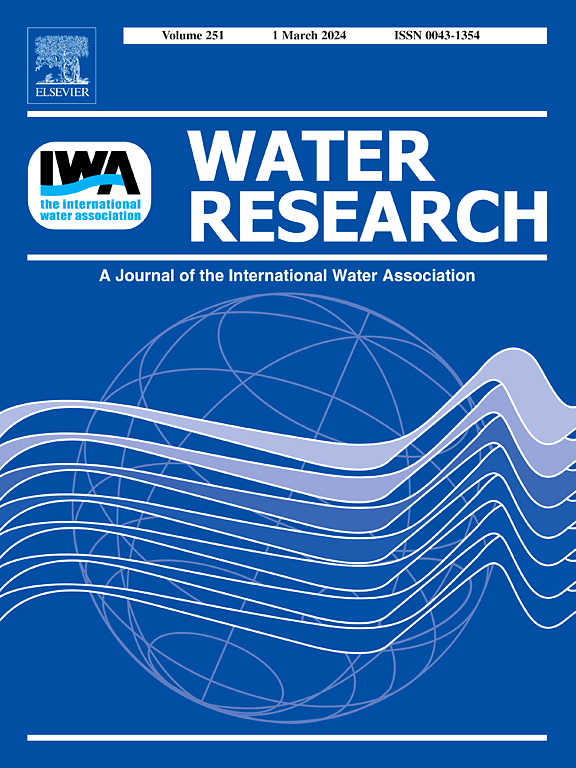森林生态水文过程表征在调节流域氮流失中的作用被忽视
IF 12.4
1区 环境科学与生态学
Q1 ENGINEERING, ENVIRONMENTAL
引用次数: 0
摘要
森林生态水文功能涉及对流域管理至关重要的多种水和生态系统服务。然而,与农业和化石燃料发电厂等污染源相比,这些问题受到的关注有限。本研究采用野外采样、遥感和改进的森林生态水文表征的SWAT模型相结合的方法,系统分析了森林流域氮素(N)流失特征、途径和来源。改进后的SWAT在模拟森林叶面积指数(LAI)、蒸散量(ET)和产水沙量的机理上有所提高(月LAI和月ET的决定系数分别提高了0.64和0.11)。利用改进的SWAT和原位采样方法,确定了不同来源的氮素损失模式和物理机制。结果表明,有机氮(ORGN)损失占上游地区森林氮损失的主导地位,占总ORGN负荷的44.37%。在上游森林(0.11±0.3 kg/ha)和农田(16.21±36.13 kg/ha)中,由于砾石含量高和土壤饱和导水率高,硝酸盐淋溶程度较高。与世界范围内类似的北温带地区的森林或森林流域的比较表明,具有高渗透性的欠发达土壤通常比其他土壤类型具有更高的硝酸盐淋滤负荷,范围为0.5至39 kg/ha/年。最值得注意的是,对比分析表明,原始SWAT对林地的ORGN、硝酸盐损失和硝酸盐淋失负荷的高估幅度分别为9.69%、26.98%和24.03%。在N源计算中如此大的差异可能会潜在地误导旨在减少来自扩散源的N负荷的缓解策略。促进可持续性和水质的高级流域管理应采取一种综合办法,承认森林在土壤-水连续体中的生态-水文功能。本文章由计算机程序翻译,如有差异,请以英文原文为准。


The neglected role of forest eco-hydrological process representation in regulating watershed nitrogen loss
Forest eco-hydrological functions are relevant to multiple water and ecosystem services essential for watershed management. However, these have received limited attention compared to pollution sources such as farming and fossil fuel power plants. In this study, we systematically analyzed the characteristics, pathways, and sources of nitrogen (N) loss in a forested watershed using a combination of field sampling, remote sensing, and a modified Soil and Water Assessment Tool (SWAT) model with enhanced forest eco-hydrological representation. The modified SWAT has improved the performance in simulating forest leaf area index (LAI), evapotranspiration (ET), and water and sediment yield from a mechanistic perspective (the coefficient of determination increased by 0.64 and 0.11 for monthly LAI and ET, respectively). The modified SWAT and in situ sampling were then utilized to identify the N loss pattern and physical mechanism of various sources. The results show that organic N (ORGN) loss dominated the forest N loss and contributed up to 44.37 % of the total ORGN load in the upstream area. High nitrate leaching was observed in both upstream forest (0.11 ± 0.3 kg/ha) and farmland (16.21 ± 36.13 kg/ha) due to the high gravel content and soil saturated hydraulic conductivity. A comparison with forests or forested watersheds in similar northern temperate regions worldwide revealed that less-developed soil with high permeability usually has a higher nitrate leaching load than other soil types, ranging from 0.5 to 39 kg/ha/yr. Most notably, comparative analysis shows the original SWAT substantially overestimated the ORGN, nitrate loss, and nitrate leaching load from forestland by 9.69 %, 26.98 %, and 24.03 %, respectively. Such a large difference in N source calculation can potentially mislead mitigation strategies that aim to reduce N load from diffuse sources. Advanced watershed management for sustainability and water quality should adopt an integrated approach that acknowledges the forest eco-hydrological functions in the soil-aquatic continuum.
求助全文
通过发布文献求助,成功后即可免费获取论文全文。
去求助
来源期刊

Water Research
环境科学-工程:环境
CiteScore
20.80
自引率
9.40%
发文量
1307
审稿时长
38 days
期刊介绍:
Water Research, along with its open access companion journal Water Research X, serves as a platform for publishing original research papers covering various aspects of the science and technology related to the anthropogenic water cycle, water quality, and its management worldwide. The audience targeted by the journal comprises biologists, chemical engineers, chemists, civil engineers, environmental engineers, limnologists, and microbiologists. The scope of the journal include:
•Treatment processes for water and wastewaters (municipal, agricultural, industrial, and on-site treatment), including resource recovery and residuals management;
•Urban hydrology including sewer systems, stormwater management, and green infrastructure;
•Drinking water treatment and distribution;
•Potable and non-potable water reuse;
•Sanitation, public health, and risk assessment;
•Anaerobic digestion, solid and hazardous waste management, including source characterization and the effects and control of leachates and gaseous emissions;
•Contaminants (chemical, microbial, anthropogenic particles such as nanoparticles or microplastics) and related water quality sensing, monitoring, fate, and assessment;
•Anthropogenic impacts on inland, tidal, coastal and urban waters, focusing on surface and ground waters, and point and non-point sources of pollution;
•Environmental restoration, linked to surface water, groundwater and groundwater remediation;
•Analysis of the interfaces between sediments and water, and between water and atmosphere, focusing specifically on anthropogenic impacts;
•Mathematical modelling, systems analysis, machine learning, and beneficial use of big data related to the anthropogenic water cycle;
•Socio-economic, policy, and regulations studies.
 求助内容:
求助内容: 应助结果提醒方式:
应助结果提醒方式:


